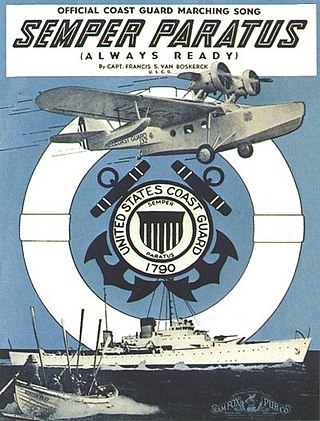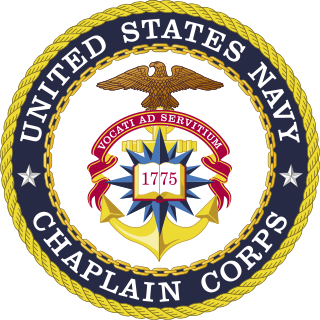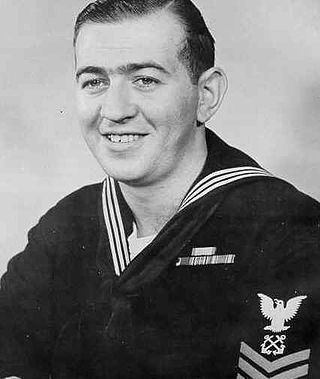
The United States Coast Guard (USCG) is the maritime security, search and rescue, and law enforcement service branch of the United States Armed Forces and one of the country's eight uniformed services. The service is a maritime, military, multi-mission service unique among the United States military branches for having a maritime law enforcement mission with jurisdiction in both domestic and international waters and a federal regulatory agency mission as part of its duties. It is the largest coast guard in the world, rivaling the capabilities and size of most navies.

James Milton Loy is a retired admiral of the United States Coast Guard who served as the acting U.S. Secretary of Homeland Security in 2005 and U.S. Deputy Secretary of Homeland Security (DHS) from November 4, 2003, to March 1, 2005. Prior to his appointment as deputy secretary, he served as the second administrator of the Transportation Security Administration from 2002 to 2003, and before that as the commandant of the U.S. Coast Guard from 1998 to 2002. Also in 2004, Loy was elected as a fellow of the National Academy of Public Administration.
The Ranger Creed is the official creed of the United States Army Rangers. The Ranger Creed was written in 1974 by CSM Neal R. Gentry, the original command sergeant major of the reactivated 1st Ranger Battalion. It was initiated by the Battalion Commander, then-LTC Kenneth C. Leuer, and re-drafted by the battalion XO, MAJ "Rock" Hudson and finalized at Fort Stewart, Georgia in 1974 when the original cadre deployed there on 1 July 1974. Today, members of Ranger community recite the Ranger Creed during formations, ceremonies, physical training activities and upon graduations from the Ranger Assessment and Selection Program (RASP) and the U.S. Army Ranger Course.

The United States Coast Guard Academy (USCGA), located in New London, Connecticut, is the U.S. service academy specifically for the United States Coast Guard. Founded in 1876, the academy provides education to future Coast Guard officers in one of nine major fields of study.

The United States Coast Guard Auxiliary is the uniformed, non-military volunteer component of the United States Coast Guard. Congress established the unit on 23 June 1939, as the United States Coast Guard Reserve. On February 19, 1941, the entity was renamed the United States Coast Guard Auxiliary. The Auxiliary's purpose is to bolster all USCG undertakings both at sea and in the sky, with the exception of tasks necessitating "direct" law enforcement or military actions. As of 2022, the U.S. Coast Guard Auxiliary boasted around 21,000 members.

The United States Coast Guard Reserve is the reserve component of the United States Coast Guard. It is organized, trained, administered, and supplied under the direction of the Commandant of the Coast Guard through the Assistant Commandant for Reserve (CG-R).

The commandant of the Coast Guard is the service chief and highest-ranking member of the United States Coast Guard. The commandant is an admiral, appointed for a four-year term by the president of the United States upon confirmation by the United States Senate. The commandant is assisted by a vice commandant, who is also an admiral, and two area commanders and two deputy commandants, all of whom are vice admirals.

Russell Randolph Waesche, Sr. served as the eighth Commandant of the United States Coast Guard from 1936 to 1946, overseeing the service during World War II. He was the U.S. Coast Guard's longest serving commandant, having served ten years in that post. In addition, he was the first officer to hold the ranks of vice admiral and admiral within the Coast Guard.

Harry Gabriel Hamlet was the seventh Commandant of the United States Coast Guard, from 1932 to 1936.

The Soldier's Creed is a standard by which all United States Army personnel are expected to live. All U.S. Army enlisted personnel are taught the Soldier's Creed during basic training, and recite the creed in public ceremonies at the conclusion of training. Both the Soldier's Creed and the Noncommissioned Officer's Creed are required knowledge at enlisted promotion boards to compete for the rank of sergeant and above, as well as 'Soldier of the Month' boards. It is also common practice to recite the Soldier's Creed at the graduation ceremony from Army ROTC. Unlike the U.S. Uniformed Services Oath of Office or the Oath of Enlistment, the Soldier's Creed is not a legally-binding oath and can be affirmed by both commissioned officers and enlisted soldiers.

"Semper Paratus" is the official song and march of the United States Coast Guard. It was composed by U.S. Coast Guard Captain Francis Saltus Van Boskerck in 1927. It made its debut in 1928.
This article covers the organization of the United States Coast Guard.

USCGC Waesche (WMSL-751) is the second Legend-class cutter of the United States Coast Guard.

The Chaplain of the United States Coast Guard (COCG) is the senior chaplain of the United States Coast Guard (USCG) and is attached to USCG headquarters in Washington, D.C. as a United States Navy Chaplain Corps officer who reports directly to the Commandant of the Coast Guard. The current Chaplain of the Coast Guard is Captain Jennifer Bowden.
The U.S. Army Creed of the Noncommissioned Officer, otherwise known as the Noncommissioned Officer's Creed, and commonly shortened to the NCO creed, is a tool used in the United States Army to educate and remind enlisted leaders of their responsibilities and authority, and serves as a code of conduct. Each branch has their own version, and many have been altered over the years.

The Chaplain of the United States Marine Corps (CHMC) is a position always filled by the officers serving as Deputy Chief of Chaplains of the United States Navy as a "dual hatted" billet since 2000. The CHMC oversees religious ministry in the Marine Corps which one Commandant of the Marine Corps defined as "a vital function which enhances the personal, family, and community readiness of our Marines, sailors, and their families. Chaplaincy supports the foundational principle of free exercise of religion and helps to enrich the spiritual, moral and ethical fabric of the military."

Charles Ward "Tommy" Thomas was a flag officer in the United States Coast Guard and commanding officer of the icebreakers USCGC Northland (WPG-49) and USCGC Eastwind (WAGB-279) that served in the Greenland Patrol during World War II. In August 1945 he was appointed commander of Greenland Patrol. After the war he was commanding officer of USCGC Northwind (WAGB-282) during Operation Highjump; The United States Navy Antarctic Developments Project 1946–1947, also known as the Fourth Byrd Antarctic Expedition. Later followed expeditions in the Bering Sea.

The Junior Reserve Officers' Training Corps (JROTC) is a federal program sponsored by the United States Armed Forces in high schools and also in some middle schools across the United States and at US military bases across the world. The program was originally created as part of the National Defense Act of 1916 and later expanded under the 1964 ROTC Vitalization Act.

Bernard Challen Webber was a United States coast guardsman. He was a petty officer assigned to Coast Guard Station Chatham, Massachusetts, where one of his duties was that of coxswain of Coast Guard Motor Lifeboat CG 36500. Webber and his crew of three rescued the crew of the stricken T2 tanker SS Pendleton, which had broken in half during a storm on February 18, 1952 off Cape Cod. Webber maneuvered the 36-foot lifeboat under Pendleton's stern as the tanker's crew, trapped in the stern section, abandoned the wreck of their ship on a Jacob's ladder into the Coast Guard motor lifeboat.
















